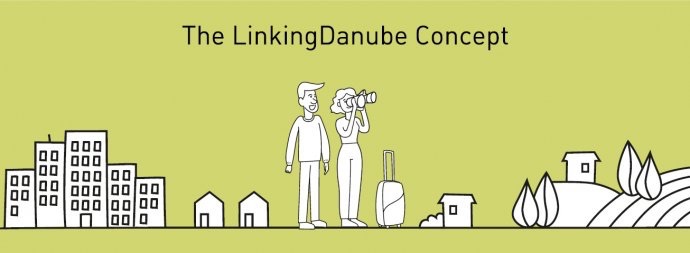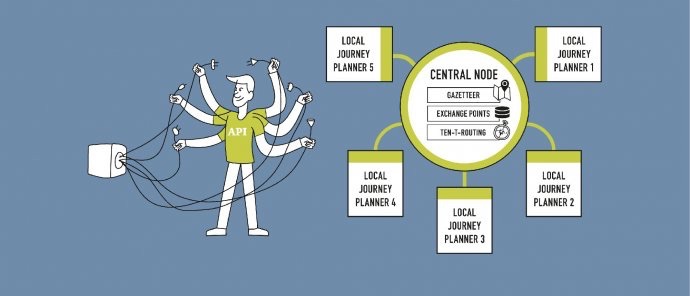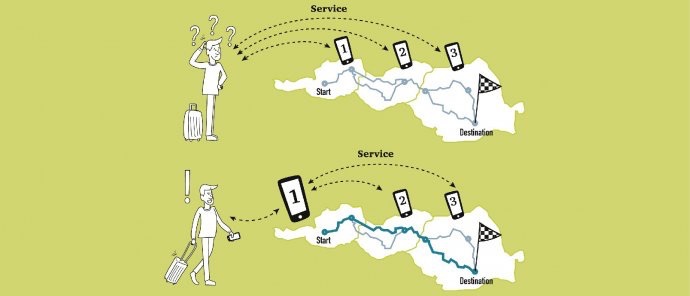Sep 26, 2018
The "LinkingDanube" project takes up the challenge of making travel information easily and comprehensively accessible. In our interview with the project managers Dr. Bettina Neuhäuser and Alexander Hausmann, we examine the details and talk about the development of the project as well as the next steps.

In the future, travelling will become so simple and flexible that you will feel like a fish in the water. This will get possible if you can easily access all the existing mobility offers like carsharing, bus, train or bicycle, without any hurdles. Therefore the various transport modes and connections need be linked like an ocean of routes, without stopping at national borders or the business areas of different infrastructure operators.
A fundamental problem, however, is the accessibility of traveller information. In the "LinkingDanube" project coordinated by AustriaTech, a concept was developed to make this information accessible multimodally and across borders: According to the concept, the traveller information services of different transport operators will be linked across national borders. It is therefore sufficient to only consult one route planner, i.e. the one you have at your fingertips at the moment. The respective route planner connects via an interface with different providers from other business areas and requests the necessary information.
We talked to the project managers Dr. Bettina Neuhäuser and Alexander Hausmann about the advantageous impacts of their concept and investigated the question of what vision underlies their work.
You have been working on "LinkingDanube" for almost two years now. Can you describe the development process of the project? I imagine that ideas like this do not arise overnight.
Neuhäuser: In “LinkingDanube” many mechanisms intertwined. Of course, the European Commission plays a decisive role here, as it stipulates in delegated legal acts how, for example, data on travel information is to be handled by the member states. Does the data need to be provided by them? In which format should this be done? The regulatory framework therefore determines implementation, but does not set any thematic research priorities.
Hausmann: That happens much more from an ongoing development. On the one hand, as in this case, the "Danube Transnational Programme" provides a certain focus within projects can be submitted. The focus is also based on the results of previous projects, which in this case was the "EDITS" project (editor's note: also a project with AustriaTech participation). This project has already dealt with cross-border travel information.
Neuhäuser: Exactly, EDITS has for the first time dealt with cross-border data exchange in the field of travel information systems and connected individual and public transport. The aim was to test how data exchange between transport operators could look like. With this physical data exchange, the data of the respective other operators had to be entered into their own databases. Data formats and update processes had to be coordinated with all partners. This meant a relatively high effort for data integration. In addition, not all operators are willing to hand over data. Often there are concerns that the own data will not be passed on to the end customers in the desired quality and up-to-dateness. One loses a bit of sovereignty over the provision of information.
"With this decentralized approach, operators do not have to worry that their data records will be stored away from home. On the other hand, a network of partner systems is created that connects their systems to each other."
How does the LinkingDanube approach differ from previous methods?
Neuhäuser: The basis of the system is a common standardized interface. This means that the data itself is not exchanged, but remains stored on the servers of the source systems, i.e. the respective operator in the respective country. A web interface, so-called API, which implements each of these systems, then enables communication between the systems. The information is only retrieved from the source system as required, and the data is stored decentrally.
Hausmann: With this decentralized approach, operators do not have to worry that their data records will be stored away from home. On the other hand, a network of partner systems is created that connects their systems to each other. A so-called "distributed system" is created and a central data pool becomes unnecessary. However, there are now different architectures for such distributed systems. In the Danube region we are dealing with a very heterogeneous organisation and technical equipment of the individual operators. Therefore, we propose a central communication node that is intelligent enough to address each of the other systems, retrieve information, merge it and communicate it to another linked system.
Neuhäuser: Exactly, so the main work is done by one system, yet the architecture basically remains a distributed one. In principle, it would also be possible for all systems to be so intelligent and to collect and merge queries. Here we would have a net-like architecture in which the systems speak to each other on an equal footing, i.e. on a peer-to-peer basis. The operators themselves must decide what role they want to play in the distributed system.
That sounds quite complicated. We're talking about a kind of informant running back and forth between different systems?
Neuhäuser: Something like that. Basically, the API is nothing more than a web service that enables other services to retrieve information on demand and integrate this information into their own services. The user doesn't notice anything, these queries run in the background. We always like to use the comparison with a waiter here. Although I sit in an Austrian restaurant, I can put together a menu from Hungarian, Slovenian and Romanian dishes. Because my waiter is smart enough to check the dishes at the respective restaurants and bring them to the home restaurant. In a restaurant it might sound boring if I always stay in the same environment, but with route planners it can be a decisive advantage and very comfortable for the users.

Do we already have one of these waiters in use in Austria?
Hausmann: Yes, with Traffic Information Austria (VAO) we already have a national multimodal platform that uses the mentioned API in a pilot and communicates with systems from the partner countries Hungary, Slovenia, Slovakia, Czech Republic and Romania.
How did AustriaTech come to play the leading role in this project?
Neuhäuser: That was simply because we had years of experience here. During the implementation of the ITS action plan, for example, we accompanied the development of the Traffic Information Austria (VAO) right from the start and were able to expand our know-how with regard to data and service interfaces and the networking of operators not only in the EDITS project, but also in other Europe-wide projects such as In-Time, Co-Cities or Rail4SEE. This also requires an examination of European standards and norms. The fact that we then took on the role of coordinator for the LinkingDanube project is largely due to years of work in this area.
Can you explain the advantages for travellers in more detail?
Hausmann: In order to establish a large-scale mobility system that doesn't end at a border and that, so to speak, forces travellers to first find out "what app do I need here now?" and "is there any travel information in my language at all", we link existing travel information systems with each other. This means that I could travel from Vienna to Bucharest with my usual travel app.
Neuhäuser: Travellers enjoy many advantages. On the one hand, they can rely on the familiar functionality of their usual travel information service and on the other hand, this service is extended by further information. For example, information on continuous, cross-border routes, or the additional services offered by other modes of transport. This makes access to information both more convenient and more efficient. You feel like a fish in the water, because you are always on familiar ground and can easily reach all destinations.
"Ideally, it should lead to a reduction of individual traffic by making people aware that there are indeed practical, fast and comfortable alternatives to the personal car."
What effects on the transport system are conceivable?
Hausmann: The advantage of such integrated systems is always to be found in the multimodal approach. Ideally, it should lead to a reduction of individual traffic by making people aware that there are indeed practical, fast and comfortable alternatives to the personal car.
Neuhäuser: Access to information alone is often a major barrier. So if you have to ask three information systems, which you might not really know, it can be quite challenging to just to get the information about how to get from door to door. We want to dismantle these hurdles in order to make mobility offers away from one's own car better known and more attractive.

Is there also such a thing as a vision of the future mobility system that drives you?
Hausmann: Absolutely. From an European point of view, we have already addressed this matter. For example, there is the "White Paper on Transport" of 2011 or the 2020 Strategy, which describe the European visions of a holistic multimodal transport system. Multimodality and the interlinking of different types of transport are the main focus.
Neuhäuser: Of course in the future it would also be nice if you only had to buy one ticket for your trip, no matter how often you change to another mode of transport or country. Or, to think even further, you no longer have an annual ticket for the subway or suburban train, but for the entire mobility system. A kind of subscription with which I could use car sharing, bike sharing, rental cars, buses, trains, trams and taxis in equal measure. However, we now have to lay the foundations for this by managing the cross-modal distribution of information.
What are the next steps?
Neuhäuser: We are now in a process of persuasion. We want to give operators the opportunity to familiarize themselves with these technologies and to implement them in their systems on a pilot basis. They must ask themselves whether they themselves want to be central nodes in European travel information in the future. Because it is not just a question of achieving a final result and, for example, implementing the "Danube Region Journey Planner", i.e. a travel information service for the entire Danube region. It's also about learning and development processes among the stakeholders and partners involved, so that we can move into an operational phase later.
Hausmann: I would also see this as an opportunity. Because linking services extends the reach and business areas of the individual operators.
Neuhäuser: By the end of the year we will still be busy with the technical implementation, but from next year the distributed system with all its components will be completed and the attractiveness for the end customer will also be presented in demonstrations.
If you would like to learn more about the LinkingDanube concept, you can read the brochure online here or order it by e-mail. The interview was conducted by Florian Hack, AustriaTech editorial team.